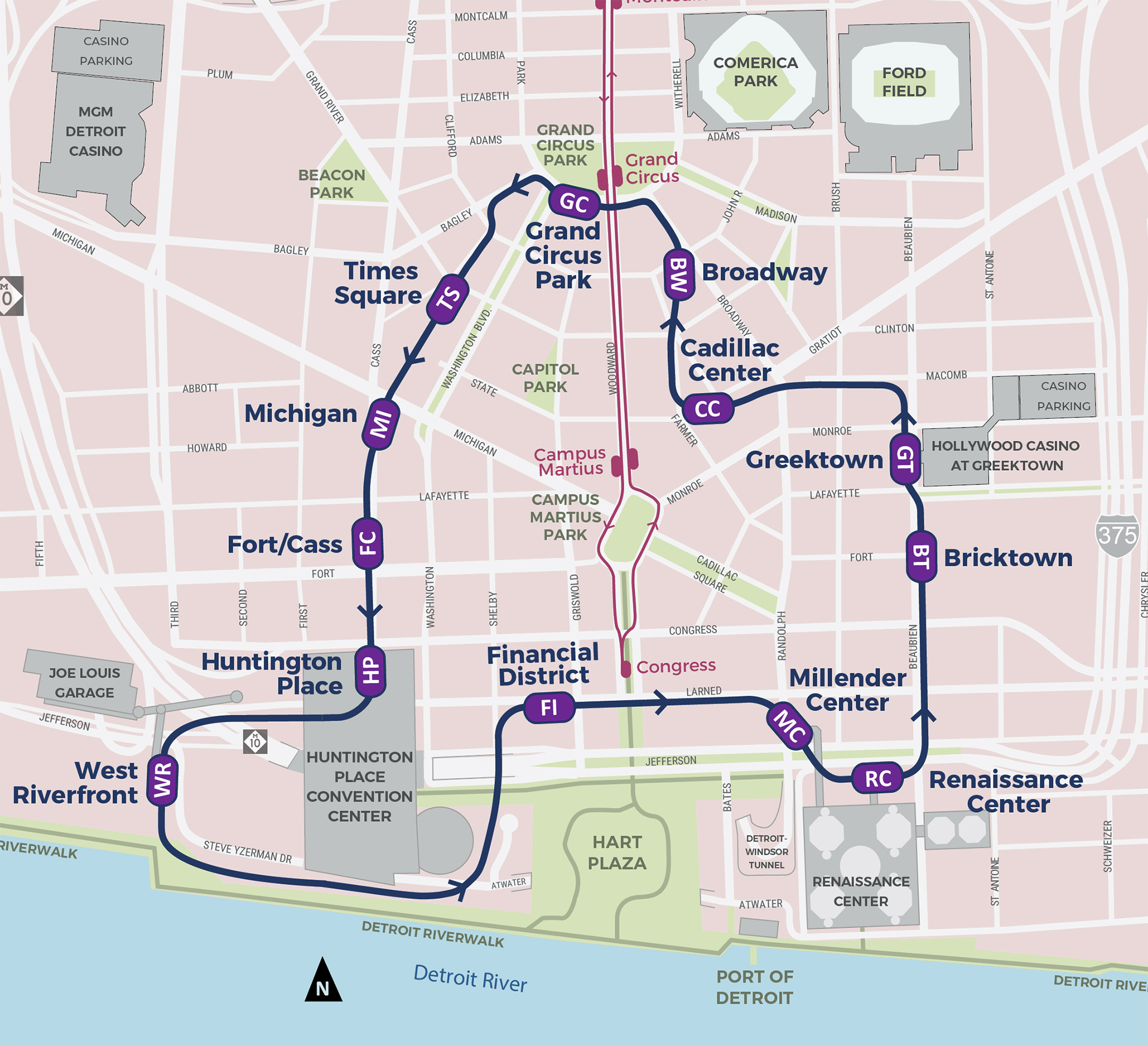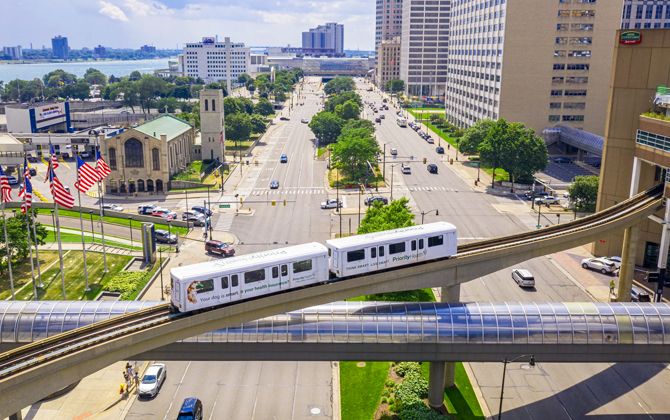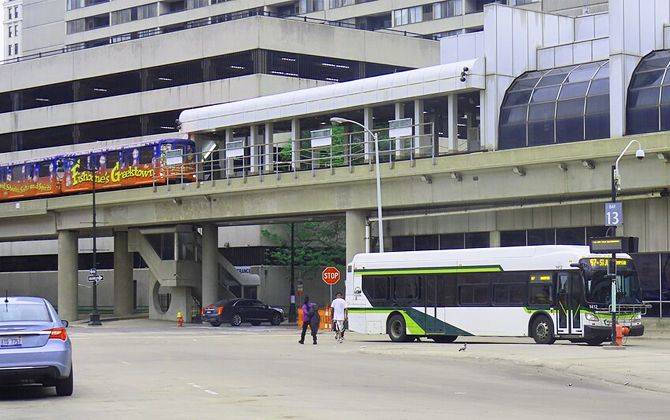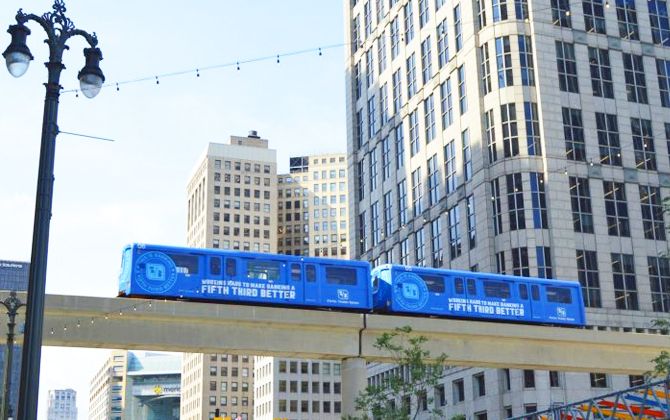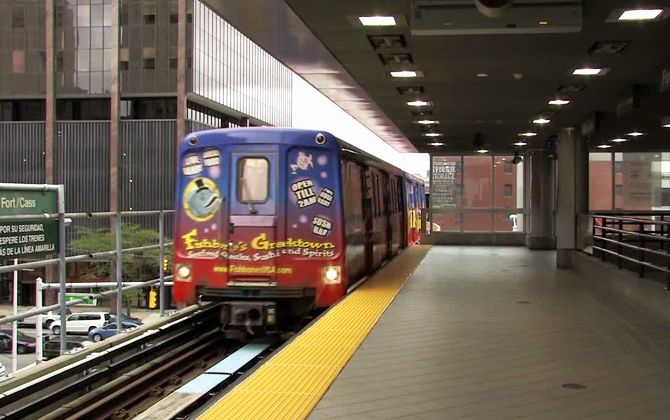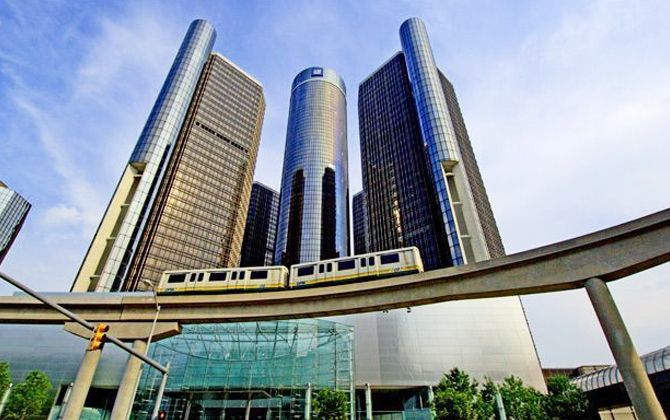The Detroit People Mover (DPM) is an elevated automated transit system that runs in a one-way loop through downtown Detroit. The route is 4.73 km (2.94 miles) long and includes 13 stations.
The system is owned by the Detroit Transportation Corporation. In 2024, it carried about 1,075,200 riders, which equals roughly 3,900 passengers on a typical weekday.
Since January 2024, the DPM has been fare-free under a pilot program sponsored by Priority Waste. This program will continue through 2025, allowing all passengers to ride at no cost.
Detroit People Mover Map
The People Mover is the backbone of downtown Detroit’s rail network. It connects with the QLINE streetcar on Woodward Avenue and with DDOT and SMART bus routes.
In practice, the People Mover links central attractions and major bus hubs, serving the role of a light downtown metro system.
Map of Detroit People Mover showing different lines. Click on the map to enlarge it or download the map in PDF format.
Lines and Stations of the People Mover
The People Mover operates on a single circular line through downtown Detroit. Trains run clockwise and stop at 13 stations in this order:
- Times Square (TS) – Park Ave & Grand River Ave, next to the Rosa Parks Transit Center (main bus hub). Serves Beacon Park, Capitol Park, nearby offices, and is within walking distance of MGM Grand Casino.
- Michigan (MI) – Cass Ave & Michigan Ave. Close to the Detroit Public Safety Headquarters and federal offices.
- Fort/Cass (FC) – Cass Ave & Fort St. Near the Federal Courthouse and Wayne County Community College.
- Huntington Place (HP) – Inside Huntington Place Convention Center (formerly Cobo) on Washington Blvd. Serves conventions and expos.
- Water Square (WS) – 3rd St & Jefferson Ave on the riverfront. Adjacent to Wilson Centennial Park and JOE Parking Garage. Formerly called West Riverfront station; renamed in 2025.
- Financial District (FI) – Larned St & Shelby St, near Hart Plaza and Detroit City Hall. Offers a QLINE connection at Congress Street.
- Millender Center (MC) – Randolph & Jefferson Ave, inside the Millender Center complex. Direct access to the GM Renaissance Center via pedestrian bridge and the Tunnel Bus to Windsor.
- Renaissance Center (RC) – 2nd level of Tower 200 in the GM Renaissance Center. Close to the Detroit Riverwalk and GM headquarters, with riverfront access.
- Bricktown (BT) – Beaubien St & Fort St. Serves Lafayette Park and University of Detroit Mercy.
- Greektown (GT) – Beaubien St between Monroe & Lafayette. Attached to Hollywood Casino at Greektown. Serves the Greektown entertainment district and Monroe Street nightlife.
- Cadillac Center (CC) – Gratiot Ave & Library St, next to One Campus Martius Garage. Near Campus Martius Park, Capitol Park, and downtown shopping.
- Broadway (BW) – W. Broadway & John R St. Serves the Detroit Opera House, Ford Field (NFL), and nearby theaters such as the Gem and Music Hall.
- Grand Circus Park (GC) – Park Ave & Woodward Ave. Next to Grand Circus Park plaza, Fillmore and Fox Theaters, and Little Caesars Arena. Connects directly to the QLINE at Grand Circus Park.
- Times Square (TS) – The loop ends back at Times Square station.
Each station has a single side platform, except Times Square, which has an island platform connected to the system’s rail yard. All stations are fully ADA-accessible. Grand Circus Park and Financial District provide direct transfers to the QLINE streetcar.
Connecting with Other Services
Many downtown bus routes connect with People Mover stations. Key examples include:
- Millender Center – served by DDOT Route 3 (Grand River).
- Fort/Cass – served by Routes 1 (Vernor), 27, and 29.
- Broadway – served by Routes 6 and 40.
- Grand Circus Park and Cadillac Center – served by Route 4 (Woodward).
- Bricktown – served by Route 5 (Van Dyke/Lafayette).
- Greektown, Bricktown, Renaissance Center – served by Route 7 (Cadillac/Harper).
- Renaissance Center – served by Routes 9 (Jefferson), 92, and 96.
SMART suburban buses also stop downtown, with service at Michigan, Greektown, Renaissance Center, and Financial District stations.
The People Mover is included in the regional DART pass, which is valid on DDOT, SMART, and the QLINE.
Two special services also connect with the DPM:
- Transit Windsor’s “Tunnel Bus” to Canada stops at Times Square (via Rosa Parks Transit Center), Michigan, Fort/Cass, Financial District, Huntington Place, and Millender Center.
- D2A2 express bus between Ann Arbor and Detroit boards on Park Street across from Grand Circus Park station.
Connecting the Airport with People Mover
There is no direct rail link to Detroit Metropolitan Airport (DTW). However, the Detroit Air Xpress (DAX) shuttle connects downtown to the airport. It departs from Washington Avenue near the Michigan Avenue People Mover station.
Tickets cost $8 (≈€7.40 / $8) onboard or $6 (≈€5.50 / $6) if purchased in advance. This provides a simple connection for People Mover riders traveling to DTW.
Schedule, Timetables, and Operating Hours
People Mover trains run every 5–7 minutes during service hours. The current schedule is:
| Day | Operating Hours |
|---|---|
| Monday–Friday | 6:30 AM – 12:00 AM (midnight) |
| Saturday | 10:00 AM – 12:00 AM (midnight) |
| Sunday | 10:00 AM – 10:00 PM |
These hours were updated in 2024, with earlier weekday starts and extended weekend service.
Fare, Passes, and Tokens
From 2024 through 2025, all rides are free under a corporate sponsorship program. A single-ride ticket, a 24-hour pass, and a monthly pass (31 days) all cost $0.00 (free).
Before 2024, the regular fare was $0.75 (≈€0.70) per ride. Tokens and passes were sold at that time, but they are no longer in use.
Utilizing the People Mover
Using the system is simple. Trains arrive every few minutes. Doors open automatically at each station. Passengers wait on the platform and board when the train stops. There are no tickets, tokens, or turnstiles—boarding is free.
The system is fully automated, with no driver on board. All stations and trains are wheelchair-accessible. Since the line runs clockwise only, passengers should plan their trip to exit at the correct station. Each stop has audio and visual announcements, along with clear station signage.
Historical Overview
The People Mover was planned in the 1970s as a downtown circulator and funded with federal transit money. It opened on July 31, 1987. The first weekend offered free rides, after which a $0.50 fare was introduced.
Ridership at launch was strong—around 2,000 passengers per hour on opening day and an average of 11,000 riders per day in the first year. Civic leaders and the mayor marked the opening with a ribbon-cutting ceremony, and shortly after, the system hit a single-day record of 54,648 riders.
Over the years, the system underwent changes. In 2008, the service direction switched to clockwise to improve efficiency. Maintenance-related closures included a 1998 track collapse caused by the implosion of the J.L. Hudson building. In 2020, the system closed due to the COVID-19 pandemic, resuming limited service in May 2022. Full service across all 13 stations returned by mid-2023.
Despite these events, the People Mover has always operated on its original 4.73 km (2.94-mile) loop with no new lines added. Today, it remains a fixture of Detroit’s transit network and is fare-free under a sponsored pilot program running through 2025.
Interesting Facts
- Quick Loop: A full ride around all 13 stations takes just 13–15 minutes.
- Artwork: Each station features original artwork. In the 1980s, a volunteer group raised funds for 18 unique pieces, including murals, sculptures, and mosaics.
- Unique Fleet: The system uses 12 UTDC ICTS Mark I cars, also used in Vancouver’s SkyTrain. Cars usually run in two-car sets. They were originally white but later wrapped with advertisements.
- Fully Accessible: Every station has elevators and ramps, making the entire system wheelchair-accessible.
- Downtown Focus: The People Mover is the only rail system looping entirely within downtown. It connects key destinations such as the convention center, casinos, arenas, and parks. A proposed heavy-rail subway for Detroit was never built.
- Future Tech: Starting in 2026, the original 1987 cars will be replaced by refurbished units from Toronto’s Scarborough RT, extending the system’s lifespan.
Regulations
- All platforms in the metro are marked with a yellow line. Make sure you stay behind this line while waiting for the metro.
- CCTV cameras are installed on Metro trains for security purposes.
- Loitering in stations or trains is strictly prohibited.
- Both stations and trains are smoke free.
- Consumption of food or drink or bringing uncovered drinks into stations or trains is not allowed.
- Activities such as jumping or running are not allowed in escalators, lifts, stations and trains.
- In case of emergency, please call the emergency number 001 313 963 0171 from your mobile phone or use the emergency phone provided in trains and stations.
- Adults are expected to supervise their children in stations and trains.
- It is compulsory to wear shoes on the Underground. Make sure your shoelaces are tied.
- If you are injured while using the Metro, contact Metro staff or the emergency number to receive first aid or be transported to hospital if necessary.
- Always keep an eye on your belongings such as rucksacks, luggage, etc. when travelling by metro.
- Radios are not allowed on the Metro premises.
- For information on overcrowded days due to special events, please contact the metro customer service.
- For safety reasons, do not block or lean against the doors of the train.
- Green emergency buttons are available at stations. Use them to communicate with Metro staff in an emergency.
Upcoming Extensions
No new track extensions have been built so far, but planning is underway. In early 2025, Detroit launched an $800,000 (≈€740,000 / $800,000) mobility study of the People Mover to explore possible expansions, new stations, and costs. The study covers both short- and long-term scenarios and may guide future projects.
One visible change is the rebranding of the former West Riverfront station, renamed Water Square Station in July 2025. The area, redeveloped on the old Joe Louis Arena site, is becoming a new downtown neighborhood with apartments and a JW Marriott. A $1 million (≈€920,000 / $1,000,000) renovation of the station exterior is planned by 2026 to match the redevelopment. In addition, a new Second Avenue extension is under construction, opening around 2026, to create a direct pedestrian and bike path from downtown to the riverfront through the former arena site.
These projects strengthen the role of the People Mover—especially Water Square Station—in Detroit’s revitalized riverfront. The city will continue to study further extensions, depending on cost and demand.
Attractions in Close Proximity
Many downtown destinations are within walking distance of People Mover stations:
- Detroit Riverwalk & GM Renaissance Center – RenCen Station provides direct access to the Riverwalk promenade and GM’s Wintergarden.
- Campus Martius Park & Government Center – Cadillac Center Station connects to Capitol Park and Campus Martius Park, the heart of downtown.
- Theater District & Little Caesars Arena – Grand Circus Park Station serves the Fox and Fillmore Theaters and is steps from Little Caesars Arena.
- Detroit Opera House & Ford Field – Broadway Station is next to the Opera House and close to Ford Field, home of the Detroit Lions.
- Casinos & Entertainment – MGM Grand Casino is north of Times Square Station. Hollywood Casino at Greektown is attached to Greektown Station, with Monroe Street dining nearby.
- Huntington Place (Convention Center) – Huntington Place Station is located inside the convention center.
- Hart Plaza & City Hall – Financial District Station is a short walk from Hart Plaza on the riverfront and City Hall at Spirit Plaza.
- Lafayette Park & Nearby – Bricktown Station serves the Lafayette Park neighborhood and is close to Eastern Market on Detroit’s east side.
- Historic Sites – Michigan Station is near the Detroit Public Safety HQ and the refurbished Capitol Park, a historic downtown area.
The People Mover offers free, frequent service, making it easy to reach Detroit’s convention venues, sports arenas, cultural sites, and entertainment hubs by riding to the nearest station and walking.
